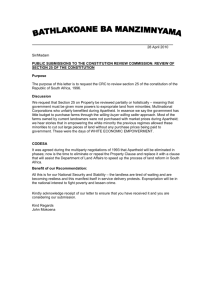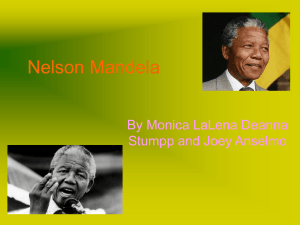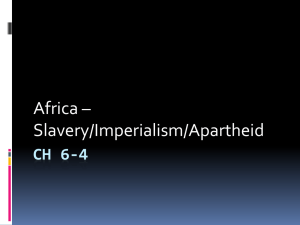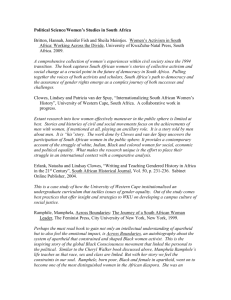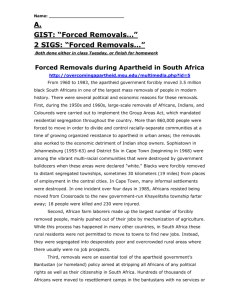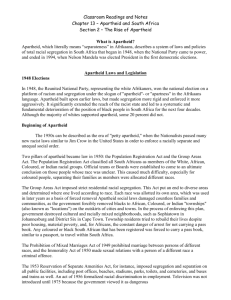The History of Apartheid in South Africa
advertisement
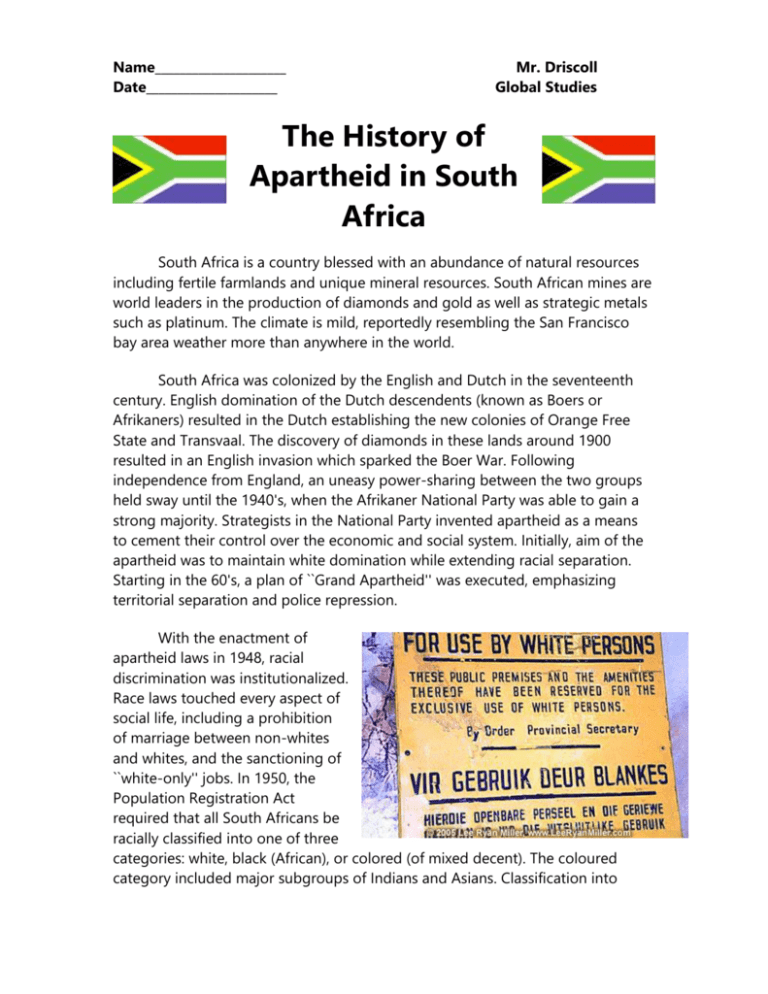
Name_____________________ Date_____________________ Mr. Driscoll Global Studies The History of Apartheid in South Africa South Africa is a country blessed with an abundance of natural resources including fertile farmlands and unique mineral resources. South African mines are world leaders in the production of diamonds and gold as well as strategic metals such as platinum. The climate is mild, reportedly resembling the San Francisco bay area weather more than anywhere in the world. South Africa was colonized by the English and Dutch in the seventeenth century. English domination of the Dutch descendents (known as Boers or Afrikaners) resulted in the Dutch establishing the new colonies of Orange Free State and Transvaal. The discovery of diamonds in these lands around 1900 resulted in an English invasion which sparked the Boer War. Following independence from England, an uneasy power-sharing between the two groups held sway until the 1940's, when the Afrikaner National Party was able to gain a strong majority. Strategists in the National Party invented apartheid as a means to cement their control over the economic and social system. Initially, aim of the apartheid was to maintain white domination while extending racial separation. Starting in the 60's, a plan of ``Grand Apartheid'' was executed, emphasizing territorial separation and police repression. With the enactment of apartheid laws in 1948, racial discrimination was institutionalized. Race laws touched every aspect of social life, including a prohibition of marriage between non-whites and whites, and the sanctioning of ``white-only'' jobs. In 1950, the Population Registration Act required that all South Africans be racially classified into one of three categories: white, black (African), or colored (of mixed decent). The coloured category included major subgroups of Indians and Asians. Classification into these categories was based on appearance, social acceptance, and descent. For example, a white person was defined as ``in appearance obviously a white person or generally accepted as a white person.'' A person could not be considered white if one of his or her parents were non-white. The determination that a person was ``obviously white'' would take into account ``his habits, education, and speech and deportment and demeanor.'' A black person would be of or accepted as a member of an African tribe or race, and a colored person is one that is not black or white. The Department of Home Affairs (a government bureau) was responsible for the classification of the citizenry. Non-compliance with the race laws were dealt with harshly. All blacks were required to carry ``pass books'' containing fingerprints, photo and information on access to non-black areas. In 1951, the Bantu Authorities Act established a basis for ethnic government in African reserves, known as ``homelands.'' These homelands were independent states to which each African was assigned by the government according to the record of origin (which was frequently inaccurate). All political rights, including voting, held by an African were restricted to the designated homeland. The idea was that they would be citizens of the homeland, losing their citizenship in South Africa and any right of involvement with the South African Parliament which held complete hegemony over the homelands. From 1976 to 1981, four of these homelands were created, denationalizing nine million South Africans. The homeland administrations refused the nominal independence, maintaining pressure for political rights within the country as a whole. Nevertheless, Africans living in the homelands needed passports to enter South Africa: aliens in their own country. In 1953, the Public Safety Act and the Criminal Law Amendment Act were passed, which empowered the government to declare stringent states of emergency and increased penalties for protesting against or supporting the repeal of a law. The penalties included fines, imprisonment and whippings. In 1960, a large group of blacks in Sharpeville refused to carry their passes; the government declared a state of emergency. The emergency lasted for 156 days, leaving 69 people dead and 187 people wounded. Wielding the Public Safety Act and the Criminal Law Amendment Act, the white regime had no intention of changing the unjust laws of apartheid. The penalties imposed on political protest, even non-violent protest, were severe. During the states of emergency which continued intermittently until 1989, anyone could be detained without a hearing by a low-level police official for up to six months. Thousands of individuals died in custody, frequently after gruesome acts of torture. Those who were tried were sentenced to death, banished, or imprisoned for life, like Nelson Mandela. The apartheid policy was highly effective of achieving its goal of preferential treatment for whites, as is demonstrated by the statistics in Figure 1. Name_____________________ Date_____________________ Mr. Driscoll Global Studies The History of Apartheid in South Africa 1. Who colonized the South African people? When? 2. Which discovery sparked a war between Dutch settlers (Boers/Afrikaners) and the invading English? 3. What was the initial aim (goal) of apartheid? When was it first enacted? 4. Describe two race laws that were enacted after apartheid was institutionalized. 5. Describe the three classifications of South African citizens. 6. What were “homelands?” Who were placed in them? Why? 7. When were States of Emergency used? What was the result in 1960? 8. Up until 1989 (nearing the end of apartheid), what happened to those who protested the apartheid system? 9. What are some statistics that demonstrate preferential treatment of whites in South Africa during apartheid? 10. What do you think happened to the apartheid system?


